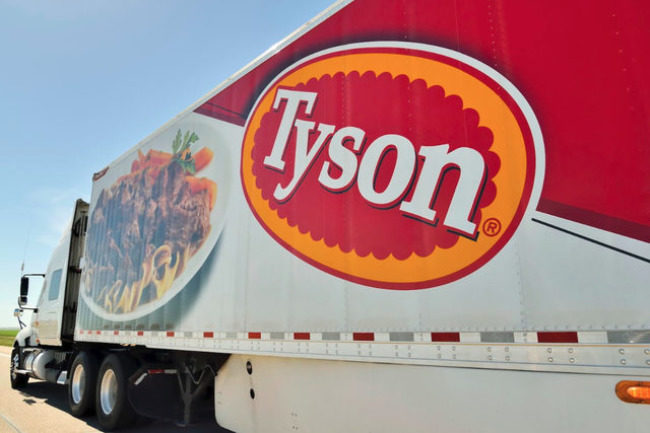SPRINGDALE, ARK. – Continued expenses related to COVID-19 and continued challenges in Tyson Foods Inc.’s chicken business segment were offset by higher operating income and sales in the company’s Beef and Prepared Foods business segments for the second fiscal quarter ended April 3, 2021. Adjusted net income for the quarter totaled $476 million, or $1.30 per share of the common stock compared to $376 million and $1.03 per share during the same period last year. Overall operating income, led by the beef segment, totaled $720 million on sales of $11.3 billion in Q2, compared to $515 million on sales of $10.89 billion in 2020, with an operating margin of 6.4% versus 4.7% in the same period last year.
Dean Banks, president and chief executive officer, said the company is challenged by significant inflation across its supply chain that will likely negatively impact Tyson’s margin in the second half of the year. Meanwhile, company officials look forward to the Chicken segment’s recovery as the industry rebounds after the onset of the global pandemic more than a year ago.
“We’re grateful for our team members’ continuing efforts and resilience, and for the collaboration and support we’ve received from our customers as we navigate these challenging times,” Banks said. “We delivered a very strong performance in a complex operating environment with continued success in retail and improvements in foodservice as the industry is recovering.”
Beef sales totaled $4.05 billion for the quarter, a volume change of 5.8% from $3.98 billion in 2020. Beef operating income increased to $445 million in the quarter over 2020’s $123 million with an adjusted operating margin of 11% compared to 3.1% the previous year.
“Average sales price increased in the second quarter and first six months of fiscal 2021 as demand for our beef products remained strong,” the company said in comments related to its beef business. “Operating income increased in the second quarter and first six months of fiscal 2021 due to strong demand as we continued to optimize revenues relative to live cattle supply, partially offset by production inefficiencies and direct incremental expenses related to COVID-19.”
Chicken segment sales, at $3.55 billion, topped the previous year’s quarter with a volume change of 3.2%, although operating income decreased to $6 million (0.2%) compared to $99 million in 2020 (2.9%). During a May 10 call with the media, company officials said factors hindering chicken segment performance included decreased egg production and hatch rates resulting from a previous change in genetics in addition to labor shortage at its plants and Winter Storm Uri, which interrupted operations throughout much of the industry’s poultry production and processing regions. Officials added that demand so far this year exceeded the company’s expectations, forcing it to purchase more raw material on the open market this year than it had planned.
Despite sales that increased to $1.48 billion over the same quarter last year at $1.27 billion, with volume declining by 0.5% compared to 17.5% in 2020. Operating income in the Pork segment lagged the previous year at $67 million (4.5%) compared to $93 million (7.3%). Sales volume reductions were attributed to fewer live hogs processed as a result of severe winter weather while operating income dropped as the result of production inefficiencies and expenses related to COVID-19, the company said.
Prepared Foods quarterly sales of $2.16 billion topped last year’s $2.08 billion with a volume change of 4.2% for the period. Operating income in the segment was $217 million, with a10% operating margin, compared to $191 million in 2020, with a margin of 9.2%.
“Sales volume decreased during the second quarter and first six months of fiscal 2021 as growth in volume across the retail channel was offset by a reduction in the foodservice channel related to lower demand from the impact of COVID-19,” the company said of its Prepared Foods segment. “Additionally, sales volume decreased during the second quarter and first six months of fiscal 2021 due to lower production throughput partially associated with a challenging labor and supply environment and the impact of severe winter weather.”
International/Other category sales were $487 million for the quarter, a 1.2% volume change compared to $465 million in 2020. Operating income for the segment in Q1 was negative $15 million compared to $9 million in the same quarter in 2020.
Looking ahead, Banks said there are reasons for optimism.
“Our long-term outlook is bright as global protein consumption continues to grow, and we expect our investments in capacity expansion, product innovation and technology to create sustainable shareholder value,” he said.
In terms of capital expenditures, Tyson expects to invest between $1.3 billion and $1.5 billion on capacity expansion, infrastructure, animal welfare and operational improvements.
In terms of managing COVID-19, the company continues to cope with multiple challenges, which is expected to negatively impact its operating costs and volumes for the remainder of the year. Approximately 42,000 workers have been vaccinated across 100 Tyson facilities to date, according to the company.
“For fiscal 2021, we estimate that we will incur approximately $365 million of direct incremental expenses associated with the impact of COVID-19; however, some of these incremental expenses may become permanent over time,” Tyson said.



